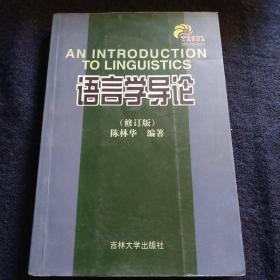
语言学导论
¥ 3 1.4折 ¥ 22 八五品
仅1件
黑龙江哈尔滨
认证卖家担保交易快速发货售后保障
作者陈林华 编
出版社吉林大学出版社
出版时间1999-06
版次2
装帧平装
货号1-6-213
上书时间2021-09-20
- 最新上架
商品详情
- 品相描述:八五品
图书标准信息
- 作者 陈林华 编
- 出版社 吉林大学出版社
- 出版时间 1999-06
- 版次 2
- ISBN 9787560122335
- 定价 22.00元
- 装帧 平装
- 开本 32开
- 纸张 胶版纸
- 页数 399页
- 字数 418千字
- 【内容简介】
-
Linguistic science has developed very rapidly in the last few decades.Books on this subject number in hundreds Courses in linguistic science are very common in olleges and universities in China.Students of foreign languages and literature are now required to take a variety of courses in linguistics.
Linguistic science has a great influence on foreign language teaching and learning. No language teacher,especially no foreign language teacher,can escape linguistic theories and principles if he or she expects to do his or her teaching work effectively and on a scientific basis
There are some excellent introductions to linguistics published in recent fifty years in China,but most of them are written in Chinese. Besides,they are mostly concerned with the Chinese language. Being students of English,they should have not only some common knowledge of general linguistics,but also some linguistic knowledge of their target language.which,I am sure,will help them a lot with their further students of English AN INTRODUCTION TO LINGUISTICS is an attempt to meet the needs of Chinese students of English who wish to do their linguistic course work in their target language. - 【目录】
-
Chapter OneLinguistice
1.Linguistics:Science of Language
2.Scope of Linguistics
3.Approaches to Language
4.Grammar
5.Schools of Linguistics
Exercise 1
Chapter Two Language
1.Understanding of Language
2.Defining Features of Language
2.1.Well-organized system of linguistic symbols
2.2.Duality of structure
2.3.Arbitrariness
2.4.Productivity
2.5.Displacement
2.6.Transferability
2.7.Cultural transmission
2.8.Linearity
3.Language,Unique to Human Beings
4.Linguistic Competence and Linguistic Performance
5.Social Functions of Language
5.1.Language,a communica tive means
5.2.Language,the means for conceptual thinking and recognition of the world
5.3.Language,the vehicle and transmitter of culture
6.Language and the Human Brain
6.1.Structure of the human brain
6.2.Functions of the brain
7.Conceptual Thinking of the Deaf-mute
8.Origin of Language
9.Animal Communication Systems
Eercise 2
Chapter Three Phonatics:Sounds of Language
1.Phonetic Alphabet
2.English Consonants and Vowels
3.Study of Phonetics
4.Articulatory Phonetics
4.1.Articulatory organs
4.2.Discription of English consonants
(1)Place of Articulation
(2)Manner of articulation
5.Natrual Classes of Speech Sounds
Exercise 3
Chapter Four Phonology:Sound Patterns of Language…
1.Phonemes:Phonological Units of Language
1.1.Distinctive features
1.2.Contrast in form and meaning
1.3.Nondistinctive features
1.4.Phones and allophones
1.5.Complementary distribution
1.6.Phonetic representation and phonemic representation
2.Suprasegmental Features
3.Sequences of Phonemes
3.1.Constraints on sequences of phonemes
3.2.Syllables
……
Chapter Five Morphology:Structure of Words
Chapter Six Syntax:Structrue of Sentences
Chapter Seven Semantics:Meaning of Language
Chapter Eight Pragmatics:Actual Use of Language in Context
Chapter Nine Language Acquisition
Chapter Ten Language and Society
Chapter Eleven Language,Thought and Culture
Chapter Twelve Historical-Comparative Linguistics
Chapter Thirteen Language Change
Chapter Fourteen Writing System
Reference Books
Glossory
点击展开
点击收起
— 没有更多了 —
















以下为对购买帮助不大的评价